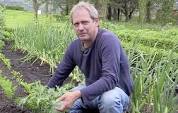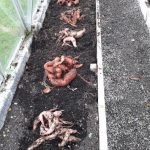 |
| Dear Fellow Gardeners, May is definitely the busiest month in your vegetable garden and hopefully you have managed to do all the other jobs such as bed preparation in the previous months. The soil has warmed up sufficiently to sow and plant nearly all vegetables. So make sure you take time off in May so that you can spend your days in the garden! Finish preparing the beds and keep the hoe and rake moving over them. Watch out for late frosts and have some horticultural fleece handy to cover your potatoes if needed. This newsletter contains:What to sow, plant and harvest in MayPest watchThe microbiome in our gut and soilSummer online gardening course open for booking now (5 sessions)Upcoming gardening courses Sowing Outdoor sowing: In the first half of May you can sow early beetroot, early carrots, parsnips, perpetual spinach, annual spinach, chard, radish, turnip, peas and runner beans directly into the ground. Towards the end of the month you can sow maincrop carrots and beetroot and any crops you didn’t manage to sow at the beginning of the month. Indoor sowing: In May you can still sow the following vegetables into modular trays: winter cabbages, Brussels sprouts, calabrese, kale, kohlrabi, swede, turnip, lettuce, scallions, spinach and chard. If you haven’t sown courgettes, pumpkins, squash, runner beans and sweetcorn yet you can still do so at the first half of the month. Towards the end of the month you can sow Florence fennel and Chinese cabbage. Seeds are available from www.greenvegetableseeds.com Planting You can plant out the crops you sowed in the previous month: the first batch of leeks, cabbage, cauliflower, Brussels sprouts, calabrese, kohlrabi, rocket, swede, turnip, lettuce, perpetual spinach, chard, annual spinach and scallions. Harvesting Towards the end of the month you may be able to harvest some oriental salads, radish, turnips and annual spinach. Pest watch Don’t forget to keep a check on your plants especially the seedlings outside. This is the time when they are most vulnerable to a slug attack. You also need to be wary of leatherjackets, the larva of the daddy-longlegs. They can be a terror during this month especially on newly planted lettuce. If a small lettuce suddenly dies, it was probably eaten by a leatherjacket. They actually just bite through the stem of the young plants. If you don’t find the culprit in the soil it will move on to the next plant. If you had carrot root fly in previous years it is nearly essential that you cover the early sown carrots with a bionet. May is the most exciting month in your tunnel or greenhouse. This is the time to plant out your summer crops – your tomatoes, peppers, aubergines, cucumbers and basil. Take good care of them and give them a fabulous soil and they will reward you with a bounty of delicious sun-ripened fruit. Once the busy spell of planting is over you can start to relax again. Microbiome There are a number of things I learned recently that I wished I would have known a lot earlier in my life. Most of our immune system (serotonin) is located in our gut and there is a direct link between the gut and our brain (gut-brain axis). A healthy gut is what we should aim for to protect ourselves. To improve our microbiome we need to increase the number and diversity of our vegetable and fruit consumption. Dr. Zach Bush reckons we need to eat at least 40 different food plants per week. Also moderate exercise and reducing stress in your life helps to promote a good microbiome. We also need to eat more fibre. Fibre has been taken out of our food and processed food and processed bread contains hardly any fibre any longer. Fibres are food for the microbes in our stomach. Dr. Will Bulsiewicz says there are nearly 40 trillion microbes in our colon – 100 times more than there are stars in the Milky Way. Even more shocking is that my body consists of 90% bacterial and other microbial cells and only of 10% Klaus cells. I’m an ecosystem of beings. Gut health and Soil health A healthy soil is a soil teeming with life, teeming with microbes. In one handful of soil there are more living creatures than there are people on Earth. These creatures are essential in keeping our garden soil fertile. This soil life is quite similar to our own inner life. A soil needs to be fed well – with a good and diverse compost or manure, some seaweed, biochar etc. and also it needs to have a great diversity of plants growing in it. A monoculture of wheat fed with NPK granules is as disastrous for the soil as highly processed food for us. Summer Session of Online Gardening Course now available for booking We are nearing the end of the first ten sessions of the online spring gardening course in the Bundoran Community Gardens with Sr Assumpta. We received such lovely feedback from so many people that we decided to continue throughout the summer. There will be five more sessions from mid May to early September. Here is the link to one of the sessions from the spring gardening course – just in case you have a few spare minutes: https://vimeo.com/694549546/33143924a7 If you are interested in joining the summer session of the online gardening course, here are the details: Summer Session – Online Gardening Course – Green Vegetable Seeds Gardening Courses This weekend (29th April – 1st May) we’ll be at the Garden Show Ireland in Antrim Castle. It’s great to have these garden festivals back. This is organised by Claire Faulkner and speakers include Diarmuid Gavin, Geoff Stebbings and many more. Garden Show Ireland – A festival of flowers, food and fun! : Garden Show Ireland Course: Growing healthy vegetables and fruit Date: Saturday 28th May 2022 Venue: Tombrack Community Gardens, Co. Wexford Contact: Denis 086 8111088 Course: Grow your own food Date: Saturday 11th June 2022 Venue: Corbalton Hall, Skryne, Co. Meath Contact: Andrina at [email protected] Happy Gardening, Klaus |

Klaus



